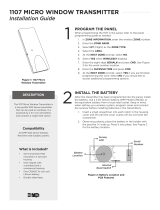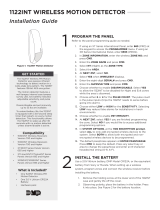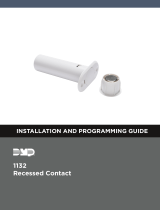Page is loading ...

1103 SERIES WIRELESS
UNIVERSAL TRANSMITTER
Installation Guide
DESCRIPTION
The 1103Series Wireless Universal
Transmitters are two-way
supervisory wireless transmitters
typically used for commercial
fire or burglary door and window
applications. The 1103E features
128-bit AES encryption.
The transmitter provides a cover
tamper, magnetic reed switch,
and an onboard terminal block for
external contact wiring. Both sets
of contacts can be programmed
to operate at the same time. This
allows two independent zones to
operate from one 1103.
The 1103Series also features
Disarm/Disable functionality. When
this option is enabled, Zone Tripped
messages are disabled when the
system is disarmed.
Compatibility
All DMP XR Series panels and all 1100
Series Wireless Receivers. For details
about XT Series compatibility, refer to
“Compatibility”.
To enable encryption on 1103E models,
Version 183 is required for XT and
XR Series panels and Version 300 is
required for Wireless Receivers.
What is Included?
• One 1103Transmitter
• One Commercial Magnet
• One 3V lithium CR123A battery
• One 470K EOL Resistor
• Hardware pack
1
PROGRAM THE PANEL
Refer to the panel programming guide as needed. After completing each of
the following steps, press CMD to advance to the next prompt.
1. At a keypad, enter 6653 (PROG) to access the Programmer Menu.
2. (1103E only) Go to SYSTEM OPTIONS. At 1100 ENCRYPTION, select
ALL to only add encrypted wireless devices to the system. Select
BOTH to allow both encrypted and non-encrypted wireless devices
to be programmed.
3. (1103E only) The default passphrase appears at the ENTER
PASSPHRASE prompt. Press CMD to keep the default. Press
any select key or area to change the passphrase and enter an
8-character hexadecimal string (0-9, A-F).
4. At ZONE INFORMATION, enter the wireless zone number.
5. At *UNUSED*, enter the zone name.
6. At ZONE TYPE, press any select key or area and select the zone
type.
7. At the NEXT ZN? prompt, select NO.
8. When WIRELESS? displays, select YES.
9. At SERIAL#, enter the eight-digit device serial number.
10. At CONTACT, select either INTERNAL or EXTERNAL.
Note: Use consecutive zone numbers if using both internal and
external contacts. Program the external contact first if using both
internal and external contacts with Disarm/Disable functionality
11. At SUPRVSN TIME, enter a supervision time. Default is 240.
12. At DISARM DISABLE, select NO or YES.
13. At the NEXT ZONE prompt, select YES if you are finished
programming the zone. Select NO if you would like to access
additional programming options.
14. To save panel programming, go to STOP and press CMD.
Figure 1: 1103 Universal Transmitter
INSTALL THE BATTERY
2
Use a 3.0V lithium battery, a DMP Model CR123A battery, or an equivalent
model from Sony or Murata. For listed installations, use either an Energizer®
123battery or a CR123A battery manufactured by Panasonic or Tekcell.
1. Push the button on the end of the transmitterand separate the two
halves.
2. Observing polarity, place the battery in the holder and press it into
place. Refer to Figure 2during installation.
Red Survey
LED
External Contact
Terminal Block
Internal Contact
Magnetic Reed Switches
Battery Location
Mounting Hole
Magnet Alignment
Marker
Magnet Alignment
Marker
Magnet
Figure 2: Transmitter Components

2 1103 INSTALLATION GUIDE | DIGITAL MONITORING PRODUCTS
MOUNT THE TRANSMITTER
Mount the Housing
When mounting the 1103, refer to Figure 2 and Figure 3 for battery and mounting hole location.
1. Remove the battery.
2. Place the supplied #4screw into the mounting hole and secure the transmitter to the surface.
3. Insert the included tamper screw and tamper as shown in Figure 3.
4. Reinsert the battery.
5. Snap the transmitter cover back onto the base.
Mount the Magnet
Only one magnet is required for internal reed switch operation, either located on the side or end of the enclosure. For
internal contact operation, the magnet should be a minimum of 1/8” from the transmitter. The maximum allowable distance
between magnets and transmitters is 1”, but may be less when mounting on metal surfaces. Refer to Figure 4 and Figure 5
during magnet installation.
Place the magnet on the surface near one of the internal reed switch locations (see the magnet alignment markers on the
transmitter base). Use the provided screws to secure the magnet in place.
4
5
WIRE EXTERNAL CONTACTS (OPTIONAL)
DMP recommends using 18or 22AWG unshielded wire. It is recommended to locate a contact within 100 feet of the
transmitter. Connect the contact as normally open (N/O) or normally closed (N/C) with the 470K end-of-line resistor. For
UL listed installations, program the external contact as Normally Closed (N/C). Refer to the Contact option under Zone
Information in the appropriate panel programming guide.
If you use both the magnet reed switch in the transmitter and an external contact, use consecutive zone numbers when
connecting them to the panel.
1. Use a flathead screwdriver to loosen the two screws on the external contact terminal block. See
Figure 6.
2. Insert external contact wiring into the terminal block and tighten the screws.
3. Connect the other ends of the wires to the external contact as either normally open (N/O) or normally closed (N/C)
with the included 470K end-of-line resistor.
4. Snap the transmitter cover back onto the base.
3
The 1103 provides a Survey LED capability to allow one person to confirm communication with the wireless receiver or panel
while the cover is removed.
1. With the cover removed, hold the transmitter in the exact desired location.
2. Press the tamper switch to send data to the panel and determine if communication is confirmed or faulty.
Confirmed: If communication is confirmed, for each press or release of the tamper switch, the LED blinks
immediately on and immediately o. Repeat this test to confirm five separate consecutive LED blinks. Any
indication otherwise means proper communication has not been established.
Faulty: If communication is faulty, the LED remains on for about 8 seconds or flashes multiple times in quick
succession. Relocate the transmitter or receiver until the LED confirms clear communication.
SELECT A LOCATION
Figure 3: Mounting the Transmitter
PCB Latch
Tamper
Screw
Tamper
Mounting
Screw
Compatibility
The 1103 has been designed primarily for use with the XR150/XR550 Series control panels. However, it can be used with the XT30/XT50
or XTL Series panels as well. When used with those panels, the tamper indication is sent via the internal contact zone only. If using
the external contact, the internal contact must also be programmed in a separate zone to provide tamper indication. In addition, the
supplied magnet must be mounted next to the 1103 internal contact to restore the zone and allow the tamper switch to have priority.
This issue does not exist when the transmitter is installed with the XR150/XR550 Series panels.

1103 INSTALLATION GUIDE | DIGITAL MONITORING PRODUCTS 3
Figure 4: Installing External Contacts
EXTERNAL CONTACTS
Parallel for N/O
Series for N/C
External Contact
Terminal Block
1103
Door
Window
External
Contact
Magnet
Program an internal
contact as the next
consecutive zone.
Program an
external contact as
the first zone.
6
TEST THE TRANSMITTER
After the transmitterhas been installed, test to confirm that it is communicating reliably with the panel. Use the Tech APP™
to perform a Wireless Walk Test on the system or complete the following steps to perform a Walk Test from a keypad that
is connected to the panel.
At the keypad, enter 8144 (WALK) and select WLS. If the transmitter fails to check in at the keypad, ensure that it is wired
properly and check for sources of interference such as metal objects and electronic equipment.
ADDITIONAL INFORMATION
Supervision Time
When a receiver is installed, powered up, or the panel is reset, the supervision time for transmitters is reset. If the receiver has been
powered down for more than one hour, wireless transmitters may take up to an additional hour to send a supervision message unless
tripped, tampered, or powered up. This operation extends battery life for transmitters. A missing message may display on the keypad
until the transmitter sends a supervision message.
Replace the Battery and Sensor Reset to Clear LOBAT
1. Push the button on the end of the transmitterand separate the two halves.
2. Remove the old battery, observe polarity, and place the new battery in the holder.
3. Snap the cover back on the transmitter.
Once the battery is replaced, a sensor reset is required at the keypad to clear the LOBAT message. On an LCD keypad, press and hold
2for two seconds. On a graphic touchscreen keypad, press RESET. Enter your user code, if required. The keypad displays SENSORS
OFF followed by SENSORS ON.
Compatibility
The 1103 has been designed primarily for use with the XR150/XR550 Series control panels. However, it can be used with the XT30/XT50
or XTL Series panels as well. When used with those panels, the tamper indication is sent via the internal contact zone only. If using
the external contact, the internal contact must also be programmed in a separate zone to provide tamper indication. In addition, the
supplied magnet must be mounted next to the 1103 internal contact to restore the zone and allow the tamper switch to have priority.
This issue does not exist when the transmitter is installed with the XR150/XR550 Series panels.
Compatibility
The 1103 has been designed primarily for use with the XR150/XR550 Series control panels. However, it can be used with the XT30/XT50
or XTL Series panels as well. When used with those panels, the tamper indication is sent via the internal contact zone only. If using
the external contact, the internal contact must also be programmed in a separate zone to provide tamper indication. In addition, the
supplied magnet must be mounted next to the 1103 internal contact to restore the zone and allow the tamper switch to have priority.
This issue does not exist when the transmitter is installed with the XR150/XR550 Series panels.

Designed, engineered, and
manufactured in Springfield, MO
using U.S. and global components.
LT-0702 1.05 20164
1103 WIRELESS
UNIVERSAL TRANSMITTER
Specifications
Battery
Life Expectancy 5 years (normal operation)
Type 3.0V lithium CR123A
Frequency Range: 905-924 MHz
Dimensions
Transmitter Case 3.3” L x 1.6” W x 1.0” H
Magnet Housing 1.5” L X 0.5” W X 0.7” H
Magnet Spacer 1.5” L X 0.5” W X 0.1” H
Housing Material Flame retardant ABS
Ordering Information
1103-W Standard Universal Transmitter
1103E-W Encrypted Universal Transmitter
Compatibility
1100X Wireless Receiver Version 104 or higher
1100XH Wireless Receiver Version 105 or higher
1100D Wireless Receiver Version 104 or higher
1100DI Wireless Receiver Version 105 or higher
1100DH Wireless Receiver Version 105 or higher
XT50 Series panels with integrated wireless receiver Version 101 or
higher
XTLplus with integrated wireless receiver Version 104 or higher
XTLtouch with integrated wireless receiver Version 104 and higher
Encryption
XT and XR Series Panels Version 183 or higher
Wireless Receivers Version 300 or higher
Patents
U. S. Patent No. 7,239,236
Certifications
California State Fire Marshal (CSFM)
FCC Part 15 Registration ID CCKPC0191
New York City (FDNY COA #6167)
Industry Canada Registration ID 5251A-PC0191
Underwriters Laboratories (UL) Listed
ANSI/UL 365 Police Station Connected Burglar
ANSI/UL 609 Local Burglar Alarm Units and
Systems
ANSI/UL 634 Connections and Switches for use
with Burglar Alarm Systems
ANSI/UL 1023 Household Burglar Alarm System Units
ANSI/UL 1076 Proprietary Burglar Alarm Units
ANSI/UL 1610 Central Station Burglar Alarm Units
ANSI/UL 864 Fire Protective Signaling Systems
INTRUSION • FIRE • ACCESS • NETWORKS
2500 North Partnership Boulevard
Springfield, Missouri 65803-8877
800.641.4282 | DMP.com
FCC INFORMATION
This device complies with Part 15 of the FCC Rules. Operation is subject to the following two conditions:
1. This device may not cause harmful interference, and
2. this device must accept any interference received, including interference that may cause undesired operation.
The antenna used for this transmitter must be installed to provide a separation distance of at least 20 cm (7.874 in.) from all persons. It must not be located or operated in
conjunction with any other antenna or transmitter.
Changes or modifications made by the user and not expressly approved by the party responsible for compliance could void the user’s authority to operate the equipment.
Note: This equipment has been tested and found to comply with the limits for a Class B digital device, pursuant to part 15 of the FCC Rules. These limits are designed to
provide reasonable protection against harmful interference in a residential installation. This equipment generates, uses and can radiate radio frequency energy and, if not
installed and used in accordance with the instructions, may cause harmful interference to radio communications. However, there is no guarantee that interference will not
occur in a particular installation. If this equipment does cause harmful interference to radio or television reception, which can be determined by turning the equipment o and
on, the user is encouraged to try to correct the interference by one or more of the following measures:
1. Reorient or relocate the receiving antenna.
2. Increase the separation between the equipment and receiver.
3. Connect the equipment into an outlet on a circuit dierent from that to which the receiver is connected.
4. Consult the dealer or an experienced radio/TV technician for help.
INDUSTRY CANADA INFORMATION
This device complies with Industry Canada Licence-exempt RSS standards. Operation is subject to the following two conditions:
1. This device may not cause interference, and
2. this device must accept any interference, including interference that may cause undesired operation of the device.
This system has been evaluated for RF Exposure per RSS-102 and is in compliance with the limits specified by Health Canada Safety Code 6. The system must be installed at a
minimum separation distance from the antenna to a general bystander of 7.87 inches (20 cm) to maintain compliance with the General Population limits.
Le présent appareil est conforme aux CNR d’Industrie Canada applicables aux appareils radio exempts de licence. L’exploitation est autorisée aux deux conditions suivantes:
1. l’appareil ne doit pas produire de brouillage, et
2. l’utilisateur de l’appareil doit accepter tout brouillage radioélectrique subi, même si le brouillage est susceptible d’en compromettre le fonctionnement.
L’exposition aux radiofréquences de ce système a été évaluée selon la norme RSS-102 et est jugée conforme aux limites établies par le Code de sécurité 6 de Santé Canada. Le système
doit être installé à une distance minimale de 7.87 pouces (20 cm) séparant l’antenne d’une personne présente en conformité avec les limites permises d’exposition du grand public.
COMMERCIAL FIRE
1. After all transmitters are in position, the WLS option of the panel’s Walk Test must be operated and all transmitters programmed for Fire (FI) or Supervisory (SV) must show
that their checkin message was received. Refer to the panel programming guide for Trip Counter for DMP Wireless check-in Test (WLS) which describes that both numbers
of the counter must match. If not and a failed wireless zone is displayed at END, decrease that transmitters range with the receiver and perform the WLS Walk Test again.
2. For Fire Protective listed systems, the internal contact (magnet) cannot be used. For use only with normally open initiating devices that indicate normal and o-normal
(alarm) signals only (i.e. pull stations, heat detectors).
3. The transmitter must be installed within 3 ft of the initiating device when not visible after installation, such as above a ceiling or within a wall. When the transmitter is
visible after installation and is seven feet or lower from the floor, it must be installed next to the initiating device. All wiring must be inside the wall.
/















